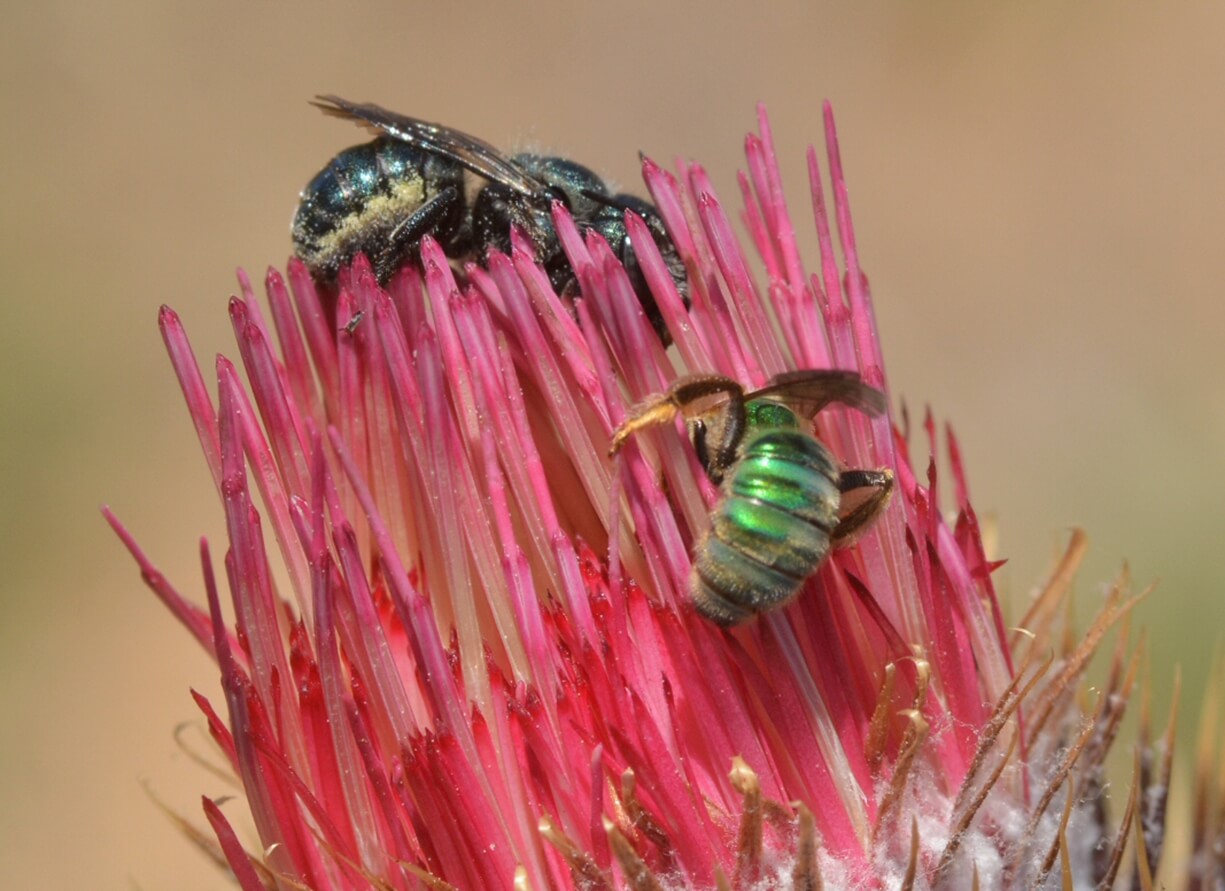Micro-Habitats; Knowing Your Land
My husband and I live on a south facing hillside situated above the Novato Creek floodplains; it’s a beautiful, warm, and sunny spot with a great vantage point. Our hill, called Cherry Hill on some maps, is a part of one of the ridges extending from Mt. Burdell, the 3rd highest peak in Marin County, and we’re directly facing Big Rock Ridge, the 2nd highest spot in Marin. When the skies are clear, we can actually see just a little tip of Mt. Tamalpais, the highest peak in Marin! To the east, we can see the twin peaks of Mt. Diablo, which is the highest peak of all in our area and therefore the base meridian of much of northern California.
The views are wonderful here on our land, but the rainfall is sometimes disappointing; while other places in Marin are measuring and inch or so, we might get ¼ of an inch of rain! We’re in a rain shadow; I can see all the rain falling on the north side of Big Rock Ridge and in Indian Valley, but the clouds are often blown east. If they do get to our side, there’s not much moisture left.
Even so, with not much more than an inch of rain, I’m witnessing an almost instantaneous re-greening of the landscape! Within days thousands of seeds are germinating; lots of grasses, and a great variety of weeds and wildflowers. This is where the fun begins. I love the challenge of identifying these minute plantlets. Sometimes I’m already so familiar with the plant that I know it from the cotyledons, but very often I need to see the first true leaves before I really know what they are.
Thinking About Weeds
Annual grass seeds are amongst the first to germinate, and of course wild oats (Avena species) are well represented. Wild oats, very different looking than the native Oatgrass (Danthonia californica) were introduced from Europe and brought to California, most likely with the very first Spanish settlers who brought livestock, and with them the seeds of these grasses. In Europe, during the olden times, the leafy new spring growth of one wild oat species (Avena sativa) was used as a medicinal to treat various conditions, including diminished sex drive. This is where the term “sowing one’s wild oats” originates from!
Along with the annual grasses come lots of thistle seedlings; their cotyledons are large and somewhat spoon-shaped. I can identify Italian thistles (Carduus pycnocephalus) easily when the first set of small and somewhat spiky, medium-green true leaves have developed. Some of the non-native weeds, including thistles, that plague wild areas in Marin, are thought to have been brought to the county by Samuel P. Taylor in raw materials for his paper mill. At first there was plenty of wood pulp locally available, but as those sources dwindled, and while the demand for paper kept going up, he also made paper using rags that were imported from Europe. It’s within these supplies that the seeds of some European weeds are thought to have “hitched a ride”.
Here’s where my thoughts about weeds differ from those of many others; weeds are not all bad! People emigrating to new lands have always brought plants with them for various purposes, such as for food or medicines, feed for livestock or for useful tools. Fennel (Foeniculum vulgare) and ‘Onion Grass’ (Allium triquetrum) were food plants, Blessed Milkthistle (Silybum marianum) is a useful medicinal plant, and Teasel (Dipsacus species) came with settlers because the dried seed heads are the best tool for hand-carding wool. The early settlers must have thought they were doing a good thing when these useful plants not only adapted to, but thrived in their new homelands.
Now, some of these species are considered a plague in our wild places, but a number of them are actually also good habitat plants, supporting all sorts of life. Various thistle species support a great number of insect species and also birds and small mammals. Hummingbirds take advantage of the nectar, all sorts of bees gather both nectar and pollen from the flowers, and later on, when the seeds have set, Goldfinches flock to the plants for nourishment. They eat the seeds, and they also breed later than many small birds, partly in order to gather the thistledown which they use to line their tiny open cup nests. American Goldfinches are the ‘sad thistle eaters’ (Carduelis tristis) and they are one of the few songbirds that feed their fast growing nestlings with seeds, not insects.
There are a number of thistles in the genus Cirsium native to California; but one non-native is the Bull Thistle (Cirsium vulgare), with big beautiful purple flowers. This species is one we’re authorized to pull at Samuel P. Taylor Park where I help out with the on-going ‘Zen of Weeding’ project. Large seedlings are easy to identify, with a rosette of soft oblong leaves that are fringed with small spines; and since they are a biennial plant, we have time to get to them out long before seed set. We use a hori-hori knife to make sure we get the taproot out. Manual methods like hand weeding are really the best way to control small populations or scattered individuals, but the timing is critical; get it done before the plants get too big and spiky, or before flower buds are formed, and most certainly before seeds have set!
Native Thistles
One of the most beautiful of all thistles, the Cobweb Thistle (Cirsium occidentale var. occidentale) is native to California and never invasive. Cobweb Thistle is a stunning plant with almost white leaves and gorgeous deep pink flowers barely emerging from an involucre that displays a webby wooliness on the outer surface. This thistle has been growing in my garden for many years now, and I love it as much as the wildlife does. But, it’s not a plant amenable to average garden culture, since it likes to decide for itself where it wants to grow! Every few years new colonies of seedlings show up in areas that get some occasional water.
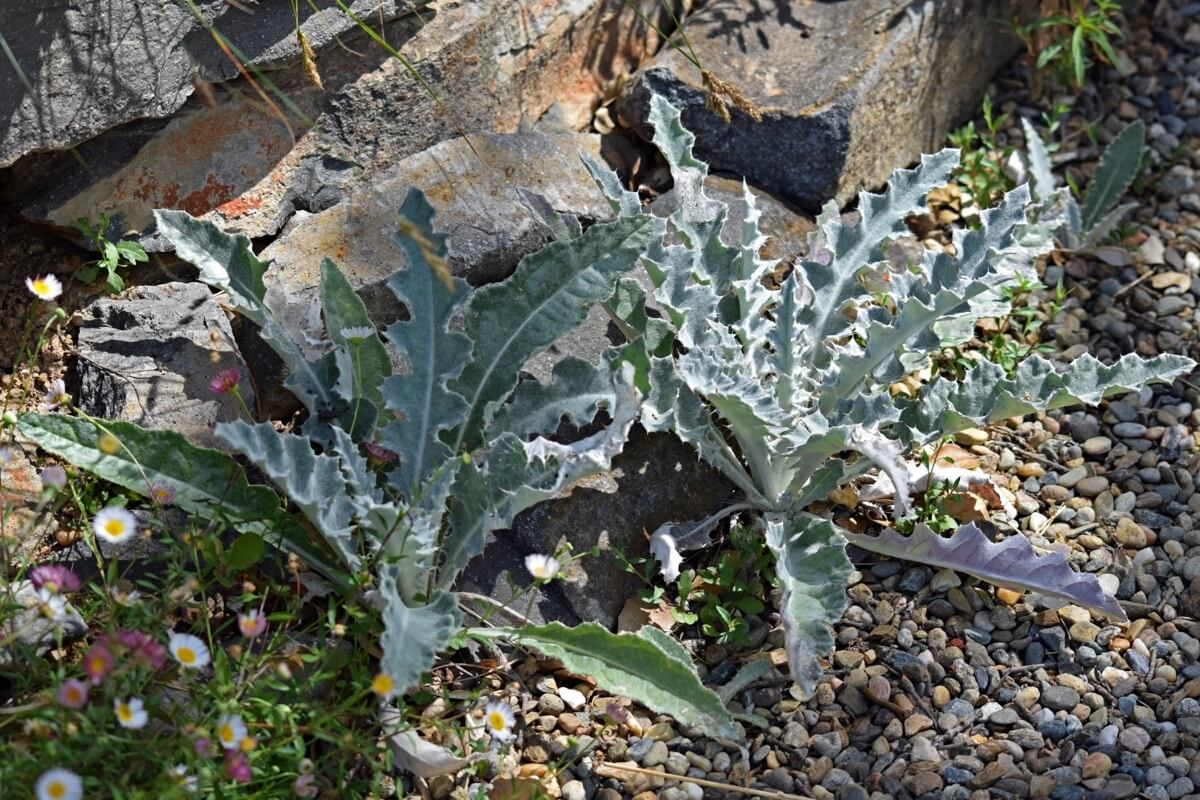
Cobweb Thistle seedlings also show up in shady areas
In the summer months the first year growth of the Cobweb Thistle becomes a completely dried-up and shriveled looking rosette of leaves that might look dead; but a strongly developed tap root is actually alive, just dormant. As soon as the first rains begin the plants come alive with new leafy growth. This unattractive summer dormancy, and the fact that a number of native plants just want to decide for themselves where to get established, can make a California habitat garden a challenging concept to many gardeners.
Furthermore, in a successful habitat garden, the animals also play a part and gardens change and evolve as “Life itself creates conditions conducive to life”. The gardener becomes more of an editor than an author, and has to make decisions about which plants, often introduced by various creatures, can stay where they are. I’m particularly thrilled when I notice that some of the native plants that I’ve planted in my garden are spreading and establishing in the wild lands around us!
I’m also getting the Venus Thistle (Cirsium occidentale var. venustum), established in my garden. It’s similar to the Cobweb Thistle, except that the leaves are greenish, the flowers are red, and held above the involucre, which is not as webby. The plants also have a much taller, lankier stature. I first noticed the Venus Thistle growing at the edges of oak woodlands along the ridge trails at Rush Creek in Novato. I collected a few seeds, grew a few seedlings in a controlled situation, and planted them out in an area with similar exposure. Now into the third year I have a small colony which is not in the same place that I first planted it; but appears to be thriving and spreading.
Other ‘Good Weeds’
A weedy plant that appears in many places is Plantain and it is a plant that is good for both animals and human beings. We have native species of Plantago, but the one that commonly grows in my garden is from Eurasia (Plantago lanceolata). It was brought with the first colonists who used the plants both for food and medicine, taking it with them, on purpose or accidentally, wherever they settled. The plants soon became known to the native peoples as ‘the white man’s footsteps’.
Leaves were eaten in the field to help relieve thirst, and also gathered before the plant bloomed to be steamed and eaten as a spring green. Leaves also served as a dressing on wounds, or were crushed and rubbed on the skin to relieve insect bites. I leave it growing in controlled drifts in my garden because it is sometimes used by the Buckeye butterfly as a host plant for their caterpillars. Since Plantain is a perennial plant, with a hardy taproot, I use my hori knife to remove those I don’t want to let grow.
Stinging (or ‘burning’) nettles (Urtica spp.) are plants that were considered very useful in olden times for both food and medicine. There are nettles native to Europe and also a California native species (U. dioica ssp. holosericea); both are herbaceous perennials found growing in lightly shaded, moist places in wild lands and in gardens. The plants are always weedy looking, with flowers that are barely visible and anything but pretty, but it’s a really good plant to know in order to avoid accidentally brushing up against it. The stinging hairs can really irritate human skin.
The fresh new growth is harvested in early spring, (with heavy gloves on) and as soon as the leaves are cooked they loose their sting. Nettles are a valuable source of nutrients, and especially high in minerals; people harvested both the leaves and roots for tea or soup, or just cooked the young leaves as an early spring green. I’ve tried (but without success) to get a nettle patch established on my property because it’s a great habitat plant! Several butterflies; Red Admirals, West Coast Lady, Satyr Anglewing, and Milbert’s Tortoiseshell use the plants as a larval host plant.
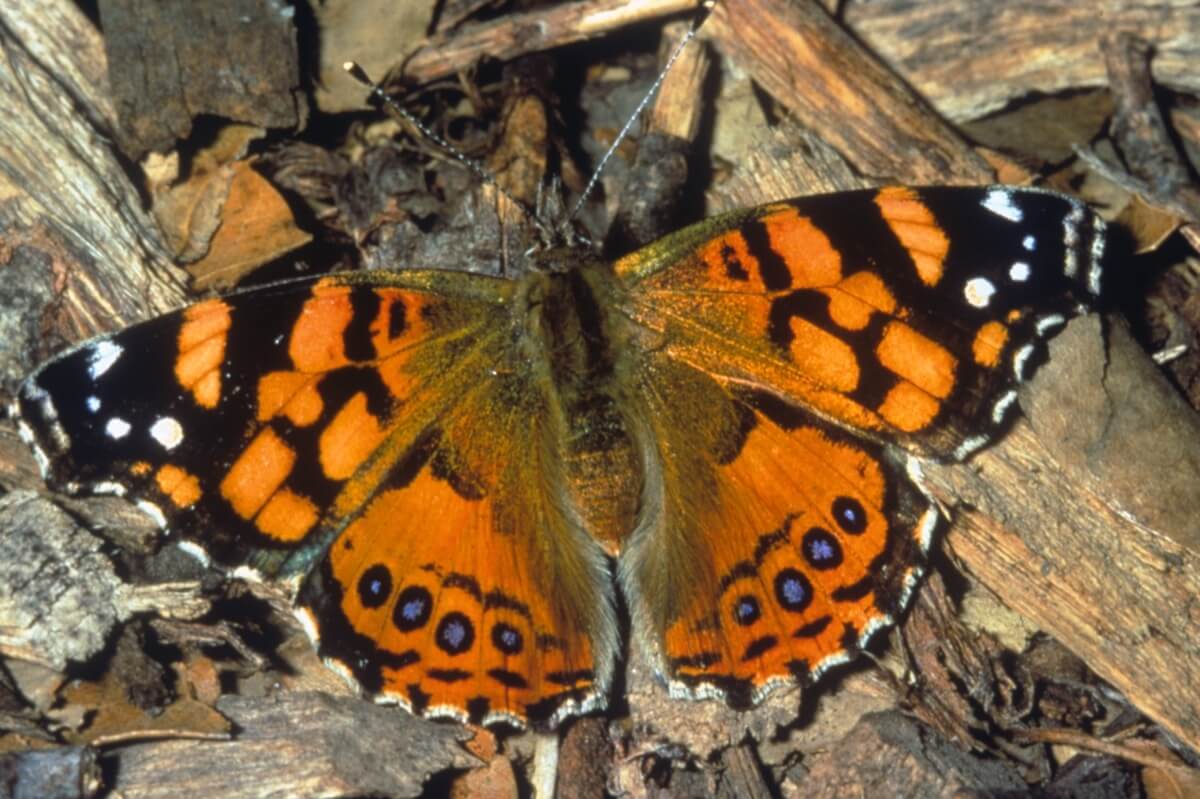
West Coast Lady butterfly, photo by Bob Stewart
My property is too dry for nettles, but I really wanted to provide for the Red Admirals (Vanessa atalanta) that are not uncommon here, even though we’re not close to a riparian system! Within the same family of plants (Urticaceae) are two non-native plants that are also used as butterfly host plants; Baby Tears (Soleirolia soleirolia) a sweet little groundcover plant for moist shady areas from Corsica and Sardinia; and Pellitory (Parietaria judaica) which is native to Eurasia. I was successful with the Pelliorty, which isn’t a pretty plant, but grows and spreads around in lightly watered areas in the garden only, and without any fuss. I have noticed an increase in the adult butterflies in my gardens, but I have yet to actually find the Red Admiral caterpillars on the Pellitory!
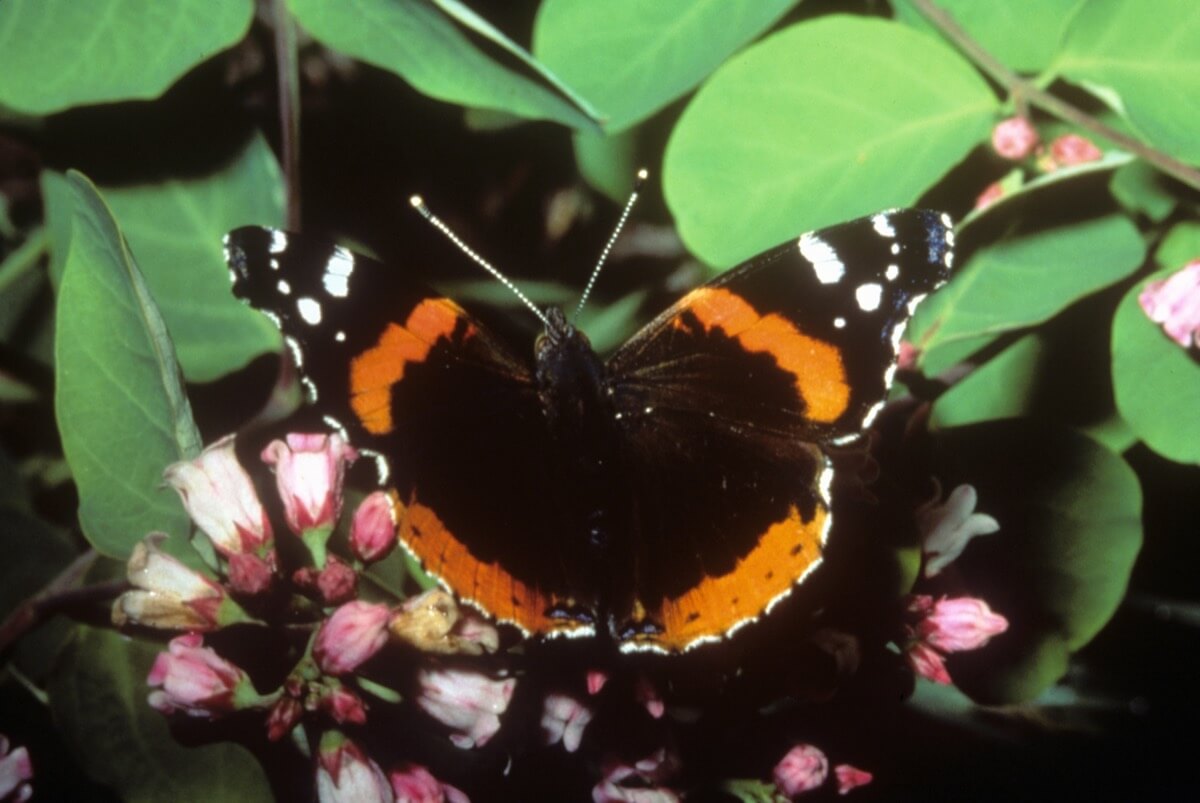
Red Admiral butterfly, photo by Bob Stewart
I consider Pennyroyal (Mentha pulegium) to be a beautiful plant; and it is very attractive to lots of insects. Bees and small butterflies can be seen swarming the plants when the lilac flowers are in bloom. The plant is native to Eurasia and North Africa, but it’s been taken all over the world because of its valuable properties, both culinary and medicinal. Pennyroyal was made into a tea to be used as an antiseptic wash for wounds, and also taken internally for various ailments. Sailors used the plant to purify drinking water on long voyages and also as an insect repellant. The smell of the plants is known to be intensely disliked by rats and mice, and so it has been used as a deterrent in graineries.
It’s been listed as an American ‘pot-herb’ since the early 1800’s, and actually grown as a crop in several countries, including India, Pakistan and Cuba. In Europe one common name is ‘grows-in-the-ditch’, and in California that’s also a good place to find this plant. It’s uncommon in much of California, growing mostly in counties along the coast from Mexico to Oregon, where it grows in disturbed places, such as plowed fields, and also by ephemeral pools or streamlets in the grasslands. I love the look of the ‘purple blush’ in the grasslands when Pennyroyal is in bloom, and also love its rich minty fragrance; not to mention that it’s nice to just to sit and watch for all the insects that show up to gather nectar and pollen from the flowers.
Native Species that can become Weedy
The most basic definition of a weed is a plant growing in a place where it is not wanted by a human. Another is a plant that is so successful in its reproductive strategies, which are often multiple, so that, once introduced, it can establish itself in great numbers in new areas. This is problematic because a plant like this can out-compete other species and create mono-cultures, which are not healthy ecosystems. A third definition is a plant that just ‘goes wild’ when conditions are particularly favorable; this is what I sometimes deal with in my garden.
I grow native milkweeds (Asclepias species) on purpose as host plants for the Monarch butterfly larvae; but they rarely ‘stay put’ where I decided to plant them! Showy Milkweed spreads by underground roots and can take over a rather large area; which is only OK in a really big garden! The Narrow-leaf Milkweed spreads itself around by seeds; as much as possible I let seedlings grow where they show up. The plants don’t need anything from me but some tending to keep the Oleander aphid populations under control.
Coyote Brush (Baccharis pilularis var. consanguinea) seedlings show up all the time, both in my irrigated garden borders and in containers with ornamental plants. The seeds are small and light, and equipped with a bit of fluff that carries them on the wind. They grow all around on our property, and in the wildlands all around us. One year I left several seedlings to grow in my borders, and by the end of the summer they were full grown shrubs crowding out other more ornamental plants.
I’ve discovered that up to a certain size, Coyote Brush seedlings are easy to dig and transplant: as larger shrubs they will sometimes survive transplanting if they are first severely cut back. Coyote Brush is a very valuable habitat plant; so I search out the small seedlings, dig them up, and transplant to skinny tube pots. Every year I’m able to provide about sixty plants of the local genetic stock of Coyote Brush to the Marin Audubon Society for their restoration sites here in Marin. Studies have recorded up to 400 species of insects that associate with these plants, and that’s a boon to birds, not to mention the thousands of tiny seeds which are also a source of food for both birds and other small creatures.
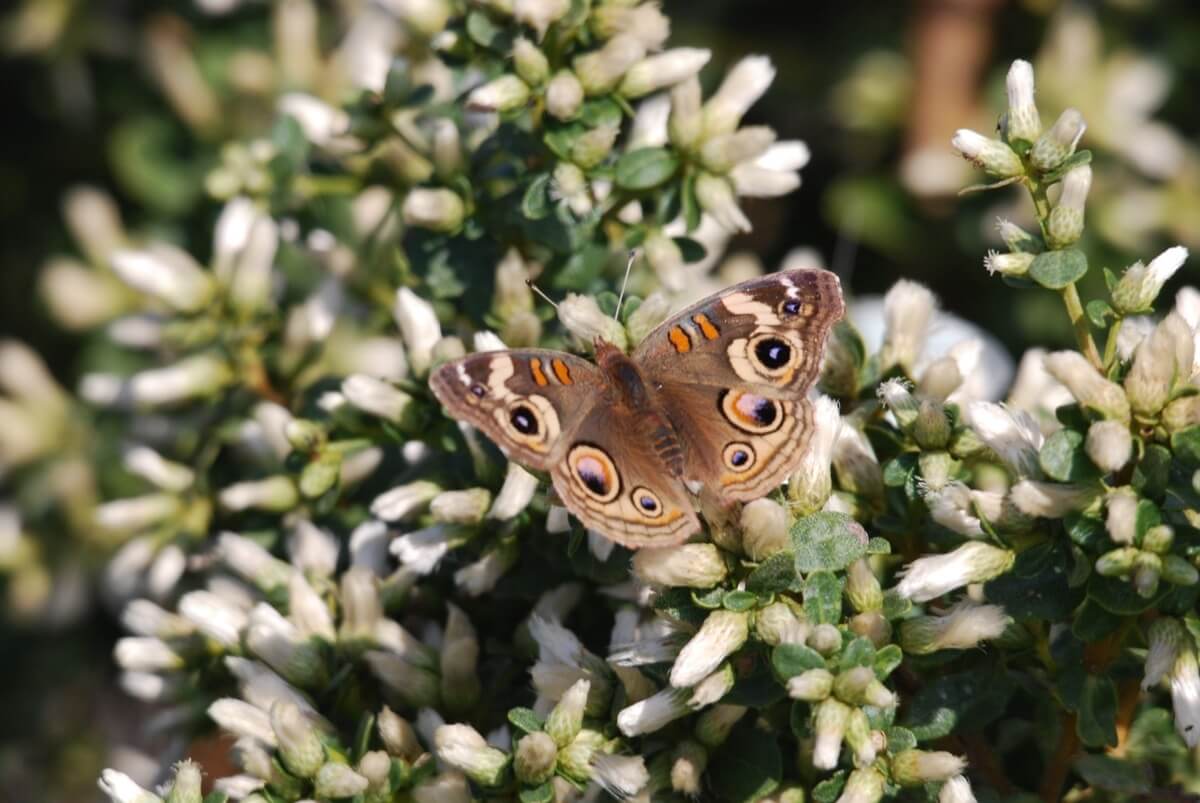
Buckeye butterfly on Coyote Bush
Species that are adapted to moist, seepy places often spread vigorously when conditions are perfect. In the wild conditions like this would occur at a natural spring, at stream or lakeside edges, or in roadside ditches, and may not last all year. In my habitat garden I create conditions like this because surface water is a valuable resource for lots of small creatures. And then I grow the plants that like the moisture: and plan to work at keeping them somewhat under control!
Yellow-eyed Grass (Sisyrinchium californicum) is a diminutive iris, and closely related to Blue-eyed Grass (Sisyrinchium bellum); the first likes the wet places, the second grows in dry sunny grasslands. Both species attract lots pollinators and set plenty of seed in small capsules. As soon as the seeds of the Yellow-eyed Grass has set and ripened it falls on moist soils and germinates, producing lots of small seedlings. These are easy to thin, pot up, or move about. The parent plants are not long-lived, and as the weather cools their leaves wither and turn grey.
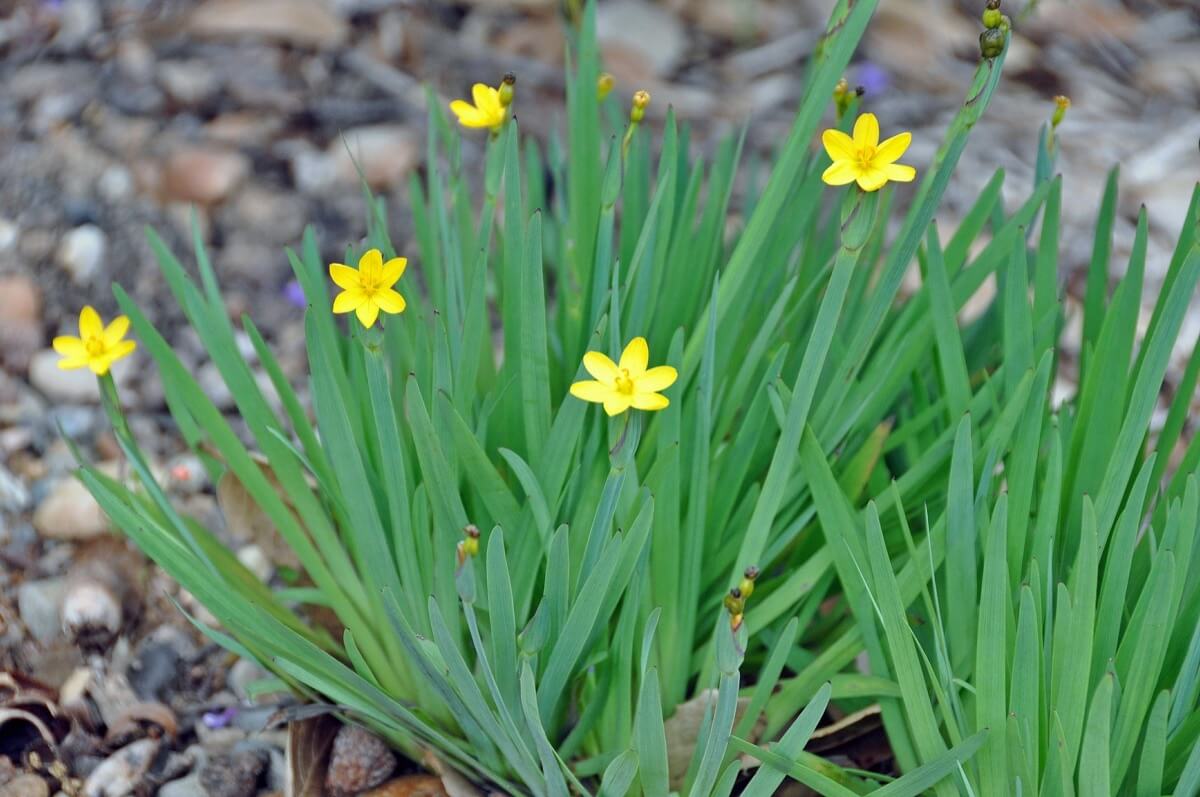
Yellow-eyed grass, a small native Iris
I also grow Rosilla, or ‘the eyeball flower’ (Helenium puberulum) in the same seepy areas. It’s a member of the Aster family with flowers that have a large, rounded disc edged with a ‘skirt’ of tiny petals. It’s a good pollinator plant, and kids, in particular, like the funny-looking flowers. It’s seeds itself around, showing up only in places that get some water, even if only occasionally.
One native plant that can become ‘weedy’ and make a nuisance of itself is the Seep-spring Monkeyflower ( Mimulus guttatus / Erythranthe guttata), but even so it’s worth having in a garden. The flowers are large and a cheerful yellow color, and the plants just like to grow, in or out of water, or in boggy or just regularly watered situations. This ‘wet Monkey’ spreads with fleshy creeping stems which root as the spread, and can quickly provide a vegetative covering at the edge of a small pond; thereby creating lots of good habitat to encourage a population of water insects and small amphibians. It will always have to be managed to avoid crowding out other species.

A seepy area in the garden where Yellow-eyed grass and Seep-spring Monkeyflower make themselves at home
I propagate a lot of plants; so I always have hundreds growing on in pots in my nursery areas. These plants are all on timed watering systems and rarely dry out completely; this is where Seep-spring Monkeyflower can really make a nuisance of itself. The seeds are literally like dust, so seedlings show up in so many other pots, and I have to be vigilant and prick them out before they get so big that they inhibit the growth of the plants I’m actually raising. Of course I pot up, and grow on, plenty of these; from that point it’s up to the other gardeners to beware!
An Abundance of Wildflowers!
The thing about native wildflowers is that it may be hard to get them to naturalize in an area; and then once they do it may be hard to keep them ‘under control’. But that’s just how it often has to be; I want the wildflowers and abundant reseeding is a mark of success. I’ll feel really successful when the wildflowers are also abundantly seeding and naturalizing into the wild meadow next to my garden!

A riot of wildflowers in spring
I’m so crazy in love with wildflowers, I want them everywhere! I’m especially fond Elegant Madia (Madia elegans), which I let grow in such abundance that it’s become a joke with my friends; are these garden pathways meant for people? Or are they for plants? How do we get through the Madia jungle? During the peak-flowering season in late summer I post ‘detour’ signs along the pathways!

The “Madia jungle” in late summer
As it happens, my pathways, which are simply tamped down native clay soil covered in pea gravel, make a wonderful seed bed! Clarkias and Gilias also germinate in the pathways, so I spend many hours carefully digging up specimens to transplant; either to ornamental containers, into small pots for sale, or to other places within garden beds. I also leave plenty of wildflowers to grow at the edges of the pathways; and the rest go onto my various compost piles.
I don’t mind weeding at all; it’s a peaceful activity, and like pruning, you can see the results right away. I also find that I can do a bit of Yoga when I’m weeding; lots of squats, back stretches while on all fours, and downward dog; just one more way that gardening is good for both body and soul!


